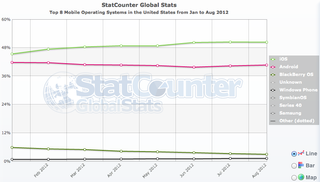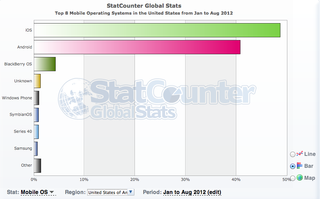Plummeting marketshare for RIM makes Windows Phone look slightly better in the US

Another Monday, another questionable story about marketshare and smartphones is making its way around the tech blogs. This one centers on data collected by StatCounter, a site that collects data usage on browsing habits. They claim to gather data on more than 3 million websites and 15 billion page views per month, making them one of the largest aggregating companies around.
Recently, WMPoweruser ran a story that looked at browser data for RIM versus Windows Phone in the United States. Assuming all the respective trajectories stay on the same course, it looks like Windows Phone may overtake RIM sometime in November of this year. But is that the whole story?

Hint: Windows Phone is the bottom one
While that makes for some nice headlines, the actual data is not nearly so cheerful. For one, it shows that RIM is bleeding much more than Windows Phone is gaining. For instance, since January they have dropped from 5.83% of the mobile market to 2.96% this month— if accurate, that is certainly a devastating number.
On the other hand, Windows Phone during the same time period has grown from 0.79% to a not-so-impressive 1.25% mobile market share. Granted, that’s a 58% increase but when your numbers are so low to begin with, it’s easy to inflate that percentage-change. Meanwhile, RIM has shed nearly 50% of its user base during the same time period. In actual customers though, RIM is hurting more than Windows Phone is gaining. That's the take away.
To put that all in perspective, Series 40 currently has a larger browser market share than Windows Phone with 1.49%. Meanwhile Android rides high at 40% and the iOS is hovering at 50%. Windows Phone ranks only slightly higher than "other" at this point.

Yay?
Get the Windows Central Newsletter
All the latest news, reviews, and guides for Windows and Xbox diehards.
And those numbers are just for the United States. Worldwide, Windows Phone is so small that StatCounter doesn’t even have a measurement.
So sure, assuming all else is equal, Windows Phone should overtake RIM in the US with a not-so massive ~1.6% share by November. But when compared to iOS and Android, it’s still a blip on the radar.
The real question is can Windows Phone 8 significantly accelerate growth more than Windows Phone 7? There is also the question of RIM, whose browser actually ranked higher than anyone else for HTML5 compatibility. While we’re almost ready to write them off, the Canadian group does have very strong carrier relations in the US, more so than Nokia and we can’t count them out yet completely.
Look, we obviously want Windows Phone to do well but we’re not gushing over these numbers. We would rather kind of forget that they even exist and return to them in December after Windows Phone 8 presumably has started to make an impact.
Source: StatCounter GlobalStats; via WMPU

Daniel Rubino is the Editor-in-chief of Windows Central. He is also the head reviewer, podcast co-host, and analyst. He has been covering Microsoft since 2007 when this site was called WMExperts (and later Windows Phone Central). His interests include Windows, laptops, next-gen computing, and wearable tech. He has reviewed laptops for over 10 years and is particularly fond of 2-in-1 convertibles, Arm64 processors, new form factors, and thin-and-light PCs. Before all this tech stuff, he worked on a Ph.D. in linguistics, performed polysomnographs in NYC, and was a motion-picture operator for 17 years.